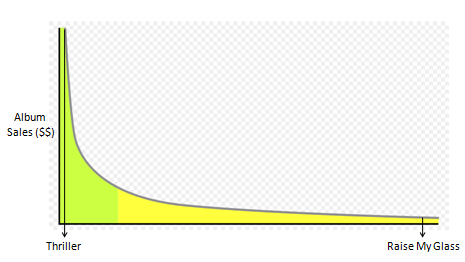The Long Tail In Action
My favorite band, Micky and the Motorcars, is releasing a new album tomorrow titled, Raise My Glass. I'm pretty excited about it. I think I first discovered the band through Pandora -- they have a similar sound to many bands that I listen to. I liked what I heard and bought a couple of albums and am now a huge fan. I was finally able to see them live at the Bowery Ballroom here in New York last month.
Without the internet, I'm certain I never would've come across their music. They're a little known "alternative country" band that doesn't get played on the radio even in Texas. They currently have less than 9,000 Facebook fans (contrast that with U2's 10 million or Dave Matthews Band's 2.4 million).
I was thinking about buying their album and I realized that the purchase will be a perfect example of the "Long Tail" theory in action. I built the graph below to help make my point.
 The graph shows album sales for Michael Jackson's Thriller versus Micky and the Motorcars album that comes out tomorrow. Thriller has sold more than 50 million copies whereas Raise My Glass will probably only sell several thousand. Marketers used to think that they had to find the next Thriller, the next huge album, if they wanted to make money. So they virtually ignored acts that wouldn't deliver an enormous fan base. But the Long Tail theory tells us that there's actually more revenue to be had in the yellow section of the graph (the tail); that is, relatively low sales volumes of millions of different albums.; i.e. albums from bands like Micky and the Motorcars.
The graph shows album sales for Michael Jackson's Thriller versus Micky and the Motorcars album that comes out tomorrow. Thriller has sold more than 50 million copies whereas Raise My Glass will probably only sell several thousand. Marketers used to think that they had to find the next Thriller, the next huge album, if they wanted to make money. So they virtually ignored acts that wouldn't deliver an enormous fan base. But the Long Tail theory tells us that there's actually more revenue to be had in the yellow section of the graph (the tail); that is, relatively low sales volumes of millions of different albums.; i.e. albums from bands like Micky and the Motorcars.
Because of distribution and marketing limitations, it was impossible to execute on the Long Tail theory 20 years ago. But with technology, specifically the digitalization of music, the Long Tail is now no longer just a theory, it's a reality, and I'm happy to be part of it.